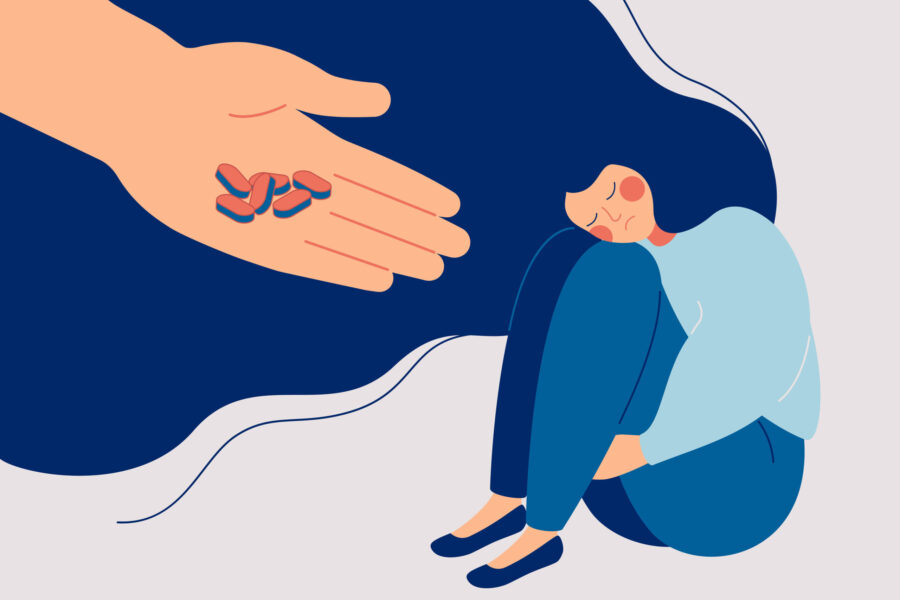Teen Antidepressant Prescriptions Spiked During Pandemic, Study Finds
The COVID-19 pandemic took a major toll on youth mental health. A new study showing that antidepressant prescriptions for adolescents spiked at the same time underscores that reality, CNN reports.
Even before the pandemic broke out in March 2020, the number of young people ages 12 to 25 prescribed antidepressants was rising. But in a study published in the journal Pediatrics, since the start of the pandemic, antidepressant dispensing rose nearly 64% faster than usual. (Dispensing does not reflect whether or not patients actually used medications, but only whether they were given to patients by a pharmacy.)
Dr. Kao-Ping Chua, the study’s lead author and assistant professor of pediatrics at the University of Michigan’s School of Public Health, said his own experiences as a pediatrician drove his research. “I found myself, during the pandemic, prescribing antidepressants at rates that I never had before,” he said.
“I can’t tell you how many pediatricians have told me that they feel like they’re just mental health clinicians at this point,” he added.
Striking gender differences in antidepressant dispensing
Gender differences in antidepressant dispensing were striking. “The differences by sex are by far the thing that stood out to me the most,” said Chua.
In 12- to 17-year-old girls, the dispensing rate increased 130% faster after March 2020, he said. For young women ages 18 to 25, the rate shot up 60%.
“In stark contrast,” Chua added, “what we see is essentially no change in antidepressant dispensing rate after March 2020 in male young adults, and a surprising decline in antidepressant dispensing rate in male adolescents.”
Why were girls prescribed antidepressants more often than boys?
It’s not evidence that boys’ mental health was better than those of their female peers. Chua says “a really concerning possibility” is that it may be evidence that males are increasingly disconnected from the mental health system.”
What’s behind the uptick in prescriptions?
Chua’s own experiences as a pediatrician drove his research. “I found myself, during the pandemic, prescribing antidepressants at rates that I never had before,” he said, adding, “I can’t tell you how many pediatricians have told me that they feel like they’re just mental health clinicians at this point.”
The study authors can’t fully account for the findings. However, youth mental health doctors unaffiliated with the study were unsurprised by the results. Dr. Neha Chaudhary, a child and adolescent psychiatrist at Massachusetts General Hospital, noted, “By the second year of the pandemic, emergency room visits for poor mental health in youth rose, and we saw an uptick in visits for suicide attempts or self-harm especially among female adolescents.”
Numerous factors may be behind the increase in antidepressant prescriptions:
Increased stressors on teens – Chaudhary notes that pandemic stressors like isolation, online learning, and grief, exposure to negative current events, and even increased awareness of mental health issues may have caused more youth to seek help.
Telehealth increased ease of access – Chua added that the rise of telehealth during the pandemic also made it easier for patients to access antidepressant medication.
Long wait times for therapy during the pandemic – One drawback to easy access is that providers may have bypassed a more traditional, non-medicated treatment path. Ordinarily, providers would recommend trying therapy without medication for patients experiencing mild to moderate depression. During the pandemic, demand for therapy shot up dramatically, leading to long wait times for new patients. To bridge the gap, some clinicians may have prescribed antidepressants earlier than they would have, assuming therapy would not be readily accessible.
Finding the proper treatment
Experts stressed that using medication should not be stigmatized. Many people take antidepressants, said Chua, “and you shouldn’t feel weird about taking them if you need them.”
“These medications are extremely effective in many cases,” he added. “They allow people to feel a little bit more normal and to withstand the highs and lows of life. People’s quality of life, their mood and rates of self-harm improve a lot.”
They can even be lifesaving in cases, added Chaudhary.
However, antidepressant medication is “not something you start trivially,” Chua said. “For young people, there’s a (US Food and Drug Administration) black box warning about increased suicidal thoughts after starting antidepressants.”
Why do antidepressants come with a warning about suicidal behavior in children?
Every antidepressant package comes with a strong warning written in bold type and surrounded by a black box. The Mayo Clinic explains why that bold warning is on every antidepressant package: “The FDA reported that an extensive analysis of clinical trials showed that antidepressants may cause or worsen suicidal thinking or behavior in a small number of children and teens. The analysis showed that some children and teens taking antidepressants had a small increase in suicidal thoughts, compared with those taking a sugar pill (placebo).”
None of the children in the study acted on those thoughts, but given the stakes, the FDA required manufacturers to print the warning on all prescription antidepressants given to patients under 25 years old, not merely the nine explored in the study.
The Mayo Clinic adds, “However, not all mental health researchers believe these warnings are necessary. Newer research indicates that the benefits of antidepressants may be greater than the risk of suicide. And some research indicates that suicide rates in children decrease when they take antidepressants.”
Weighing the pros and cons of antidepressants for youth struggling with mental health
Chua stressed that given the risks, parents need to have “a frank discussion about the pros and cons of antidepressants when their kids are having mental health concerns, and honestly, not just shut it down or push them either way,” Chua said.
Potential side effects generally wane in a few weeks; if not, a prescriber may choose an alternative medication.
A pediatric psychiatrist is best positioned to help families assess whether drastic changes in a child’s mood – such as sleep patterns, concentration, school performance, or loss of interest in formerly enjoyable activities – suggest antidepressants may be helpful.
Chaudhary stressed that antidepressants are typically only prescribed when the benefits outweigh the risks. She encouraged adults to keep a pulse on the young people in their lives.
“Young people are struggling, and it’s on us to help them,” Chaudhary said. “If you are a young person or have one in your life, consider checking in on how things are going. It just takes one person who cares to change the trajectory of someone’s life.”
Read the full article.
For extensive information on antidepressant use in children and teens, visit The Mayo Clinic.
Rogers, Kristen. “With the decline in youth mental health comes another concerning trend, study finds.” CNN.com, 26 Feb 2024, https://www.cnn.com/2024/02/26/health/antidepressant-use-spikes-after-pandemic-youth-wellness/index.html.



